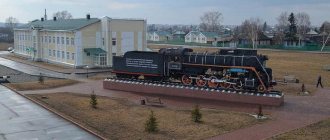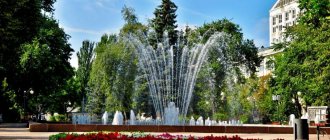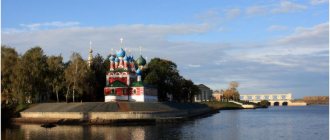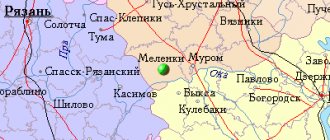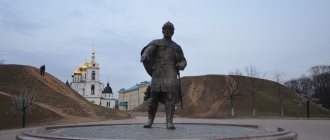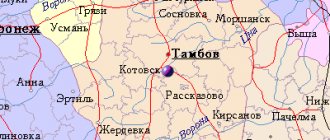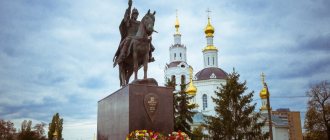- Reports and messages
- Miscellaneous
- City of Podolsk
Podolsk has a very deep and interesting history of its appearance.
As in any other city, in Podolsk there are many different legends about the appearance of the city’s name. The legend of this city tells us that Catherine II was passing through the village, but suddenly she wet the bottom edge of her dress. It's a pity, of course, that this is not true. Some people seem to have a very unique way of thinking. Because Catherine II somehow could not have ended up in these places. There is only a small percentage that she was in this city, and at that time in the village. Podolsk also played its own unique role during the Great Patriotic War. The climate of this city will be familiar to almost every citizen. Podolsk has a temperate continental climate. This means that the winters here are not harsh, like, for example, in Krasnoyarsk, they are softer and more forgiving here. It's not that cold here, mostly warm. Even during winter, the snow will always be a little melted, because the climate here is really very warm. But the most interesting thing is that there is more precipitation in summer than in winter. This means that summer here is not very pleasant. Cloudiness in the summer is extremely high, as well as fog every day, this is not news at all for this city.
The ecology in this city is also not an ideal environment for the average resident. Since there are many factories in Podolsk, and also a highway through which an enormous number of cars pass. Basically, the air is very heavily polluted in the eastern and northeastern parts of this city.
The population of Podolsk, according to data for the year two thousand and nineteen, about three hundred thousand residents live in the city. The city began to develop very quickly and rapidly, mainly after war times. There was a lot of activity in the city, the number of residents began to grow enormously quickly. The city grew very quickly, from two thousand people, literally in half a month it grew to fifteen thousand people.
This city has a lot of districts, about twelve. There is no point in talking about each one, but I will talk about them very briefly. The high-rise area has more comfortable living conditions for residents. The Zalineiny district is very large in scale. Zelenovsky district can be called the center of the city. Ivanovo district, better known as the village. The Krasnaya Gorka district is located along the highways of the city of Podolsk. The Grasshoppers district is calmer than other districts. Kutuzovsky district is the safest. Interhighway, more modern area. Central business district. Fetishchevo district, developing. Parkovy, as the name suggests, is endowed with parks and public gardens. Novo-Syrovsky district is at the stage of development.
[edit] 19th century
Main article
:
Podolsk in the 19th century
On September 6-7, 1812, Kutuzov’s army was in Podolsk, and after some time the French entered there, causing significant damage to the city.
In 1849, there were 18 stone houses in Podolsk.
In 1866, a cholera epidemic began in Podolsk.
In 1893, a trustee “Society for Charity and Shelter for Persons Without Shelter and Food” was formed in Podolsk.
In May 1898, the Ulyanov family settled in Podolsk.
In 1900, Vladimir Ilyich Lenin lived in Podolsk with the Ulyanov family.
Popular message topics
- Hogweed (poisonous plant)
In common people, hogweed was called “borscht” because of the young leaves that were used to prepare dishes. A poisonous plant from the umbrella family, it spreads every year in forests and meadows, having a very bad effect on the environment. - Moss
Spore-bearing small plants, Bryophytes, which have leaves and stems. Mosses are higher plants (organisms with vegetative organs, the most important roots and shoots), the most numerous, numbering 10 thousand species, - The Work of Oscar Wilde
Oscar Wilde wrote only one novel in his life, but this did not stop him from gaining unimaginable fame. What is so distinctive about his work?
[edit] 20th century
Main article
:
Podolsk in the 20th century
In June 1900, Lenin left Podolsk.
On the night of February 28, 1917, the first news of the overthrow of the monarchy appeared in Podolsk.
In mid-1917, water supply to the city water supply network began for the first time in Podolsk.
In September 1917, elections to the district zemstvo were held in Podolsk.
On March 30, 1939, the strongest boxers from Podolsk went to Mytishchi for the Moscow Region Championship.
In 1939, Podolsk became an independent administrative and economic unit - a city of regional subordination.
In October 1941, the front approached Podolsk.
At the beginning of November 1941, the 112th Tank Division under the command of Andrei Getman arrived in Podolsk from the Far East.
The archive of the Ministry of Defense has been located in Podolsk since 1946.
In 1948, Podolsk took first place in the competition of cities of the RSFSR for improvement.
In 1956, the Ministry of Electrical Industry separated enamel production into an independent plant.
In the USSR, the needs for microwires with special characteristics were met in the late 1950s by enterprises such as Podolsk, where in 1958, in the second workshop, under the leadership of Antonina Fedorovna Kuharkina and Viktor Semenovich (Solomonovich) Berson, the installation was put into trial operation for the production of cast microwires in continuous glass insulation.
worked since 1958 on the production of steel-copper microwires intended for ATGM - an anti-tank, wire-guided missile system.
From 1959 to 1963, bimetallic wires (steel-copper) with a diameter of 0.16 mm were produced, necessary for equipping cumulative anti-tank missiles.
On June 18, 1960, a closed Resolution of the Council of Ministers of the USSR No. 637-258 was signed on the creation of an Independent Design and Technology Bureau for microwires in Podolsk.
In 1961, the Mechanical Engineering Design Bureau (in the city of Kolomna) instructed Podolsk residents to develop a special microcontrol cable for the ATGM codenamed “Malyutka”.
In 1971, Podolsk was awarded the Order of the Red Banner of Labor for high achievements in industrial production.
The Podolsk Museum of Local Lore was founded in June 1971 by members of the Public Council under the City Executive Committee.
The exhibition hall in Podolsk was opened in 1977.
In 1980, the Podmoskovye-Podolsk hotel was reconstructed and hosted participants in the 1980 Olympics.
In 1987, the All-Russian Museum of Vocational Education was opened in Podolsk.
On September 11-13, 1987, a rock festival took place in Podolsk.
The “Festival of Unpurchased Cinema” was held in 1990 in Podolsk.
Since 1992, the Podolsk Chamber of Commerce and Industry has been operating in Podolsk.
In 1993, Podolsk received its own city television.
The consumer rights protection department of the consumer market department of the district administration has been operating in Podolsk since 1993.
In 1996, Podolsk became one of the first in the Moscow region to have a city charter approved.
In March 2000, the PROPLEX company opened a plant for the production of PVC window profiles in Podolsk.
[edit] XXI century
Main article
:
Podolsk in the XXI century
In 2001, a modern pharmaceutical enterprise was created in Podolsk - the closed joint-stock company "ZiO - Health".
In April 2001, OJSC Podolsk Machine-Building Plant (ZiO) transferred the stadium to the Severny microdistrict, in the area of \u200b\u200bthe street. Mira, into municipal ownership.
In 2002, a mortgage credit consumer cooperative of citizens “Podolsky” was created in Podolsk.
In May 2003, Alexander Serafimovich Fokin became the mayor of Podolsk.
In June 2003, the Podolsk Armenian community began to operate in Podolsk.
In 2004, Podolsk was granted the status of an urban district.
Since 2004, a psychological-medial-pedagogical commission has been working in Podolsk.
IKEA supplier Technocomf ST LLC was founded in 2005 in Podolsk. The main specialization of the company is the production of upholstered furniture and mattresses.
In December 2006, a delegation of Great Patriotic War veterans from Abkhazia visited the city of Podolsk.
The long-term target program “Providing housing for young families” has been operating in Podolsk since 2006.
In July 2007, the Day of Industrial Workers of the Moscow Region was held for the first time in Podolsk.
In 2007, a tennis academy was opened in Podolsk to train athletes for tennis.
On September 10, 2008, the grand opening of a new dealership took place in Podolsk.
Poetry rock festival “There is a way out!” has been held in Podolsk since 2009.
The Polygon club has existed in Podolsk since 2009.
The Podolsk Open Championship among children and youth in motocross has been held in Podolsk since 2010.
Based on the results of work in 2010, the municipal unitary enterprise of Podolsk "ZhPET" was awarded the challenge banner of the Head of the city of Podolsk N.I. Pestov.
The Podolsk Chemical and Metallurgical Plant went bankrupt in 2011.
On March 13, 2011, the next elections for the Head of the city district were held in Podolsk.
In October 2011, a large trade and construction complex “Molotok” began operating in Podolsk.
On November 1, 2011, the “Children” store opened in Podolsk.
Since 2011, the city of Podolsk has established a single tariff for various categories of consumers for water supply and sanitation services.
At the end of 2011, the number of unemployed in Podolsk decreased to 609 people, the unemployment rate was 0.63%.
In 2011, a Canine Service Center was created in Podolsk.
In 2012, the Administration of the city of Podolsk provided 61 apartments to citizens in need of improved housing conditions.
The “Library Night” event has been held in Podolsk since 2013.
From July 9 to July 11, 2013 in Podolsk, at the Training Center of the Federal Fire Service, the “Best in the Profession” review competition was held.
The final of the All-Russian competition “Teacher of the Year of Russia - 2013” began on September 24, 2013 in Podolsk.
On November 2, 2013, a mobile reception room of the President of the Russian Federation operated in Podolsk.
In 2014, a 2.3 km long bicycle route was installed in Podolsk in the city park named after Talalikhin.
MosObleIRC has been operating in Podolsk since 2014.
On March 18, 2014, a rally was held in Podolsk in support of the decision of the residents of Crimea to reunite with Russia.
On January 31, 2015, the XI Interregional Tournament in Army Hand-to-Hand Combat, dedicated to the withdrawal of Soviet troops from Afghanistan, took place in Podolsk.
On April 6, 2015, a unified 1C seminar was successfully held in Podolsk in the building of the Youth Palace.
On June 1, 2015, the enlarged urban district of Podolsk was formed, including, in addition to Podolsk, another 75 settlements.
On July 20, 2015, a conference of the local branch of the United Russia party was held in Podolsk.
On August 23, 2015, a regional dog show took place in Podolsk.
In 2015, the youth of Podolsk won the regional competition “Iron Entrepreneur”.
In 2015, pensions and other social benefits amounting to 14.46 billion rubles were paid in Podolsk.
The volume of industrial production in the urban district of Podolsk in 2015 increased by 5% compared to the level of the previous year.
Based on the results of 2016, Volkswagen Center Podolsk took an honorable 2nd place among the best dealerships in two capitals - Moscow and St. Petersburg.
In 2016, Podolsk received the “Breakthrough of the Year” award from the governor of the Moscow region for achievements in the field of sports.
The School of Counselors project has been operating in Podolsk since 2016.
From May 10 to May 24, 2016, employees of the State Traffic Safety Inspectorate of the Podolsk Regional Ministry of Internal Affairs checked 613 taxi drivers as part of the operational and preventive operation “Taxi”.
Neskuchny Park opened in Podolsk in June 2016 at the address: Fevralskaya Street, 65. It hosts various entertaining and educational events for children and teenagers.
The boulevard named after film director Evgeny Karelov was inaugurated in Podolsk in November 2016.
The “Ptichka” club appeared in Podolsk in the spring of 2022 and united all pigeon fanciers in the city and its surroundings.
In October 2017, a single operator for accepting payments in Podolsk signed agreements with nine management companies of the city district to organize payments for housing and communal services.
On December 16, 2022, an open rhythmic gymnastics tournament “Podolsk Blizzard” was held in Podolsk.
Presentation for the class hour “My city Podolsk” material on the topic
Slide 1
My city is Podolsk.
Slide 2
City `s history. The village of Podol (Podol-Pakhra) has been known since 1627-28 as the patrimony of the Moscow Danilov Monastery. The name is formed by the term podol (plain, floodplain, terrace above the floodplain), which reflected the location of the village. The city of Podolsk grew out of the village of Podol, known since the 17th century as a small settlement on the banks of the Pakhra River. According to surviving sources, it is known that about 270 people lived in the settlement and there were about 30 households in the settlement. Mention is made of the small wooden Church of the Resurrection of Christ, which later became white-stone. Residents of Podol were engaged in gardening, arable farming, and transportation, which was considered prestigious. Trade developed in Podol, they traded in flaxseed oil and canvas, there were inns and taverns.
Slide 3
In October 1781, Catherine the Second issued a decree in which it was ordered to rename the village Podolsk and open the Podolsk district. Among the local residents there is a witty legend, passed on to this day, that while passing through the village, Queen Catherine soaked the hem of her dress and that’s where the name Podol came from. Podolsk is surrounded by picturesque plains and vast valleys, perhaps this gave rise to the beautiful and poetic name Podol and Podolsk.
Slide 4
In the 19th century, the main occupation of the residents was trade, transportation and extraction of white stone and rubble. Beautiful houses were built from Podolsk white stone in the Moscow region and Moscow. White Podolsk stone was called local Podolsk marble. The famous Church of the Sign was built from this marble in Dubrovitsy. The economic development of Podolsk in the 19th century accelerated the construction of the Brest-Litovsk (Warsaw) road in 1844-47, and the railway in 1866. In 1900, the American JSC Singer Company began construction of a plant in Podolsk for the assembly of sewing machines and the production of parts for them. The first cars were produced in 1903.
Slide 5
Podolsk is a participant in military events. In September 1812, the city was occupied for a short time by French troops, who caused significant damage to it. In memory of these events, the Trinity Cathedral was erected in the city (now located in the city center, opposite the Karl Marx Palace of Culture).
Slide 6
The outbreak of the Civil War forced the Soviet government to resume military production. Since many military factories in Russia were occupied by the White Guards, it was decided to build a new cartridge factory in Podolsk. He occupied part of the projectile. Since the fall of 1919, it began to produce cartridges and remake foreign cartridges. On May 2, 1919, the Podolsk Steam Locomotive Repair Plant (the future Ordzhonikidze Plant) was opened in Podolsk, which was deployed on the territory of a cable and copper rolling plant.
Slide 7
During the Great Patriotic War, Podolsk was a front-line city. Although the city was bombed little, several German air raids were carried out, which tried to hit two objects: the bridge over the Pakhra River and the bank building on Strelka (now Lenin Square). Significant assistance to the front was provided by Podolsk industrial enterprises, which during the Great Patriotic War transferred all capacities from the production of civilian products to production for the defense industry: they produced ammunition, repaired tanks and other military equipment. The Ordzhonikidze Machine-Building Plant produced armored hulls for T-40 tanks and Il-2 attack aircraft. By November 1941, the plant was completely evacuated from Podolsk. In its place, a numbered plant was opened for the production of anti-tank hedgehogs, shovels, armored locomotives, and in 1942, also evacuated from Taganrog, which continued boiler production in the city.. On January 1, 1942, to the soldiers of the 43rd Army by employees of the S. Ordzhonikidze Machine-Building Plant The famous armored train "Podolsky Rabochiy" was transferred. In 1939 - 1940, artillery and infantry schools were created in Podolsk, in which more than 3 thousand cadets studied. On October 5, 1941, Podolsk cadets were alerted and defended Maloyaroslavets for several days during fierce battles.
Slide 8
Culture of the city of Podolsk Temples and churches. Trinity Cathedral. Trinity Cathedral, built in 1819 - 1832 in honor of the victory in the Patriotic War of 1812 and is a five-domed cathedral in the Empire style with a three-nave refectory and a three-tier bell tower. Among the churches in the southern Moscow region, the Trinity Cathedral is the only one with a five-domed top. The architect of the cathedral is Osip Ivanovich Bove, famous for the reconstruction of Moscow after the fire of 1812. Trinity Cathedral was created as a compositional center of urban development, so a high hill above the Pakhra River was chosen for its construction. Trinity Cathedral has its own shrines: this is the Jerusalem Icon of the Mother of God, revered by Podolsk residents for delivering the city from cholera in 1866, two relics with particles of the relics of 140 saints, an icon of the new martyrs of Podolsk. During the years of Soviet power, Trinity Cathedral was the only functioning city cathedral in the Moscow region.
Slide 9
One of the oldest churches in Podolsk is the Church of the Resurrection of the Word (or simply the Resurrection Church) on Krasnaya Street, which is mentioned in the scribe books of 1627 - 1628, when the village of Podol, which was the patrimony of the Moscow Danilov Monastery, was located on the territory of the modern city. The first church was wooden, which caused a fire in 1722. In the middle of the 19th century, the church was repaired and an independent parish was restored. But with the establishment of Soviet power, church property was confiscated, and in March 1929 the Resurrection Church was closed. Subsequently, the church was significantly destroyed (including the destruction of the bell tower), and it was turned into a workshop for the production of tombstones. An industrial technical school was built in the adjacent cemetery, where those who died from the cholera epidemic of 1848 and closed in 1924 were buried. Subsequently, the church was used for other economic purposes. The first divine liturgy took place only in 1995. Between 1995 and 1999, the Church of the Resurrection was actually revived.
Slide 10
Church of the Sign In 1690-1704. The Znamenskaya Church, remarkable in its architecture, was built. The temple builder, on the recommendation of Peter I, invited an Italian architect. His name is still not known. The church was built by foreign craftsmen and Russian serfs. The building was built from limestone quarried nearby, on the banks of the Pakhra. In 1697, when the church was ready, the location for the church was chosen surprisingly well - on a hill, where the Desna merges with the Pakhra. The temple was consecrated by Metropolitan Stefan (Yavorsky) on February 1704 in the presence of Peter I, Tsarevich Alexei and many secular and clergy. The king brought a rich gift: expensive church utensils. In 1848-1850 carried out the restoration of the Church of the Sign with funds allocated from the treasury by order of Emperor Nicholas I. In the 1930s. The Church of the Sign was closed. In 1932, the bell tower was blown up. The temple fell into disrepair. In 1947, the temple building housed the warehouses of the All-Union Scientific Research Institute of Animal Husbandry. The first Liturgy in the last 60 years was celebrated on October 14, 1990. It was led by Bishop Gregory of Mozhaisk. Complex restoration work is being carried out in the temple. The church is included in the UNESCO World Heritage List.
Slide 11
Estates. One of the famous attractions of the city is the former Ivanovskoye estate, which currently houses the Museum of Local Lore and the Museum of Professional Education of Russia. For the first time, Ivanovo as a patrimonial property was mentioned in the scribe books of 1627. At the end of the 17th century, the estate belonged to the okolnik Ivan Ivanovich Golovin and his heirs, in the second half of the 18th century - to Field Marshal Mikhail Fedotovich Kamensky. At the end of the 18th century, Ivanovskoye came into the possession of the senator, cousin of Lev Nikolaevich Tolstoy, Count Fyodor Andreevich Tolstoy. It was by his order that the artistic complex of the estate was created. After the death of Fyodor Tolstoy, the estate passed to the Count, Governor-General of Finland (1823), Moscow (1848 - 1859) Arseniy Andreevich Zakrevsky, who carried out the reconstruction of Ivanovsky. Subsequently, Ivanovskoye was the property of Countess Agrafena Fedorovna Zakrevskaya, Countess Sofia Vasilievna Keller and the Bakhrushin family, who in 1916 donated the estate to the Moscow city government for the establishment of a medical and educational institution for orphans.
Slide 12
The Golitsyn estate in Dubrovitsy is located in the village of Dubrovitsy, Podolsky district. The history of this place is inextricably linked with such famous people as Prince I. A. Golitsyn, boyar I. V. Morozov, Peter the Great. The magnificent manor in Dubrovitsy was rebuilt a lot by its owners over several centuries and over time moved from the Baroque style to classicism. The main staircase of the estate is decorated with stone lions, and a wide carriage road leads to the central entrance.
Slide 13
Urban sculptures. Lenin monument . Sculptor - Z. I. Azgur, architect - L. P. Zemskov. Installed on the central square of the city, named in his honor, on October 29, 1958. The leader of the October Socialist Revolution visited the city in July 1900. Earlier, in May 1898, the Ulyanov family settled in Podolsk. During the days spent in Podolsk, Lenin thought through the complex issues of transporting the first all-Russian illegal Marxist newspaper from abroad to Russia, illegal appearances and addresses were planned (all that ensured the publication of Iskra).
Slide 14
Monument to the Cadets of Podolsk Military Schools, who, together with units of the 43rd Army, held back the onslaught of Nazi troops and helped gain time to bring up reserves to Moscow. Authors: sculptors - Yu. Rychkov and A. Myamlin, architects - L. Zemskov and L. Skorb. Opened on May 7, 1975 at the intersection of Kirova Street, Parkovaya Street and Archive Proezd. The stainless steel monument depicts three cadets (two of them are holding machine guns, the third is holding his left hand raised), in the upper part is a star, and behind the monument is a diagram of the combat operations of Podolsk cadets. To the right of the monument is the accompanying inscription: “Dedicated to the courage, perseverance, and immortal feat of Podolsk cadets,” and to the left on the earthen parapet is a long-barreled cannon.
Slide 15
Architectural and sculptural ensemble on the 50th Anniversary of October Square, dedicated to the Great Patriotic War of 1941-1945. Authors: Y. Lyubimov and L. Zemskov. Installed in November 1971. Carved on a large concrete slab are Soviet soldiers eager to fight with grenades and machine guns, as well as the words: “To the Podolsk heroes who defended their Motherland, honor and freedom with their lives.” In 2010, the ensemble was reconstructed: to the right of the slab with carved Soviet soldiers and the stele, a memorial complex to the military and labor exploits of Podolsk residents during the Great Patriotic War was opened. The eternal flame was placed in front of the reconstructed stele. In addition, the complex included a monument to fellow countrymen who died while performing international duty in Afghanistan and combat missions in Chechnya (sculptor - Honored Artist of Russia A. A. Rozhnikov, architect M. V. Tikhomirov). At the same time, after an appeal from the council of war veterans, labor veterans, the Armed Forces and law enforcement agencies to the city administration, it was decided to call the square “Glory Square”
Slide 16
Monument-obelisk to the grenadiers of Miloradovich who fell on Podolsk land in 1812. Opened on October 2, 1912 to mark the 100th anniversary of the Patriotic War of 1812. During the years of Soviet power it was converted into a monument to Karl Marx, but was restored in 1995. Located on Cathedral Square in front of the Trinity Cathedral between Bolshaya Zelenovskaya, Fevralskaya and Revolutionary Avenue streets. Crowned with the Alexander coat of arms. There is a plaque on the monument: “September 22, 1812.” The Russians, under the command of General Miloradovich, fought all day between the villages. Voronov and Tarutin with Murat’s corps blocked the French’s path to the camp of the Russian army led by Kutuzov.”
Slide 17
Monument to Viktor Vasilyevich Talalikhin. Sculptor - Z. I. Azgur, architect - L. P. Zemskov. It was opened on May 9, 1960 with funds earned by Komsomol members. Located in the Central City Park named after. V. V. Talalikhina. The monument is a bust of the hero on a granite pedestal. On the pedestal there is the inscription “To Viktor Talilikhin” and a metal plaque with his biography and description of the feat.
Slide 18
Monument to Mikhail Illarionovich Kutuzov. Sculptor - Udalova S. M., architects - Lyubarskaya O. G., Kudrina S. V. Opened in 1995. Located in the Kutuzovo microdistrict at the intersection of Sosnovaya and Borodinskaya streets. It is a 22-meter composition, on top of which is a sculpture of Archangel Michael made of stainless steel.
Slide 19
Monument to Catherine II. Sculptor - Rozhnikov A. A., architect - Tikhomirov M. V. Opened on September 14, 2008. Located in Catherine Square near Vokzalnaya Square. The monument depicts the Empress at the moment of signing the Decree of October 5, 1781, where the entry appears: “... we most graciously command that the economic village of Podol be renamed a city...”
Slide 20
Monument to Alexander Sergeevich Pushkin. Author: Viktor Mikhailovich Mikhailov. Opened on June 6, 1999 and installed on the 200th anniversary of the poet’s birth. Located in the park to the right of the Podolsk Administration building (other places for installation were proposed: the Ivanovskoye estate, the park in front of the Lepse Palace of Culture, the square near the old city committee). The monument is a bust of the poet made of red-brown granite, which stands on a column of black granite. The position of the poet's hands is close to the portrait of Kiprensky, with the right hand placed on the shoulder and the left on the bust. On the pedestal there is an inscription: “My friend, let us dedicate our souls to our homeland with wonderful impulses.”
Slide 21
Bronze sculpture "Justice". Author - D. V. Kukkolos. Installed on December 23, 2005 on the territory of the new building of the Podolsk City Court. The Podolsk goddess of justice has classical attributes (scales, sword, blindfold), and also holds in her right hand a shield with the image of the coat of arms of Russia
Slide 22
Flag and coat of arms of the city. The current flag of Podolsk was approved on June 30, 2006. The authors of the flag are Konstantin Mochenov (flag idea), Kirill Perekhodenko (symbolism rationale), Galina Rusanova (artist and computer designer). The flag was designed taking into account the coat of arms created on the basis of the historical coat of arms of the district city of Podolsk, Moscow province, approved on March 16, 1883. The flag of the urban district of Podolsk is a rectangular panel with a width to length ratio of 2:3, divided into two parts: a smaller, red one, located in the upper part of the panel, occupies 1/5 of the length and is large, blue, bearing the image of two gold picks placed crosswise. The current coat of arms of Podolsk was approved on December 24, 2004. The historical coat of arms, Supremely approved on December 20, 1781, is taken as the basis of the coat of arms. In the azure (blue, light blue) shield there are two golden pickaxes placed crosswise.
Slide 23
Objects and colors on the coat of arms and flag of Podolsk symbolize the following: Kirks - the industrial orientation and historical type of activity of the city residents. Gold is a symbol of strength, strength, justice and independence. Azure (blue, light blue) is a symbol of honor, sincerity, virtue. Red is a symbol of belonging to the Moscow region and affirms the triumph of labor, courage, and the power of life.
Slide 24
Sister cities and partners Since 1996, Podolsk has been a member of the international association “Sister Cities”, since then taking an active part in various cooperation programs with foreign countries. Amstetten (Austria), Bar (Montenegro), Bila Tserkva (Ukraine), Borisov (Belarus), Balti (Moldova), Vanadzor (Armenia), Warmian-Masurian Voivodeship (Poland), Kavarna (Bulgaria), Kladno (Czech Republic), Ohrid Macedonia), Kvemo-Kartli region (Georgia), Saint-Ouen (France), Sukhumi (Abkhazia), Trier-Land district (Germany), Hengyang (China), Chernivtsi (Ukraine), Shumen (Bulgaria), Engels (Russia) .
Slide 25
Photo of the old city. Bolshaya Serpukhovskaya Street Bronnitskaya Street (second checkpoints of the Kalinin plant)
Slide 26
Wooden bridge over the Pakhra River (view from Krasnaya Gorka) Railway bridge over the Pakhra River
Slide 27
Zemskaya Hospital Zastava Varshavskoe Highway
Slide 28
Red Rows Manor Ivanovskoe
